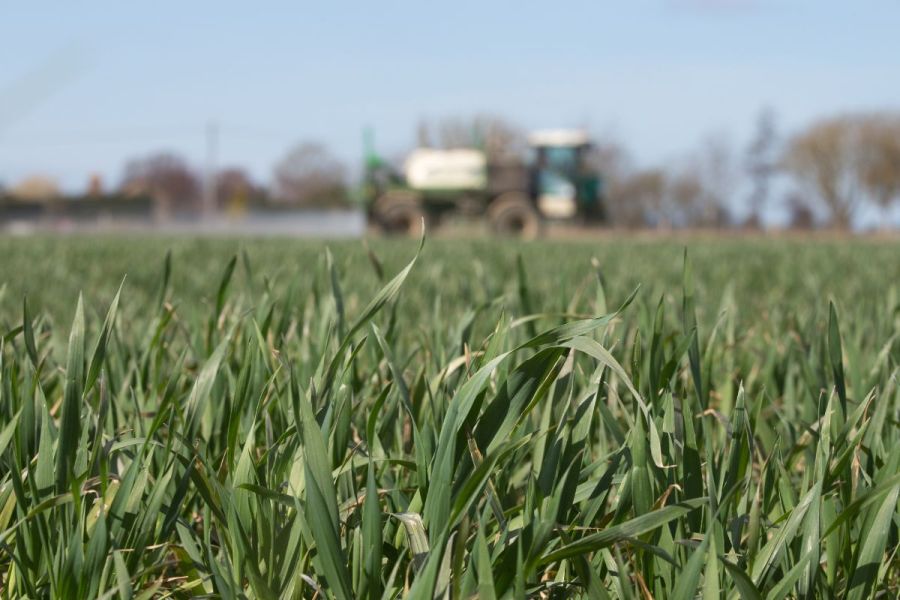Corteva has recently issued detailed best practice application advice for Inatreq-containing fungicides for the coming season after worrying problems were reported by spray operators in 2022, its first season of use. But will farmers follow it? CPM reports
“The company appears to have buried its head in the sand over the problem and is suggesting it’s everyone else’s fault.”
By Mike Abram
It was slap bang in the middle of the wheat flag leaf spray window when farming social media started to explode with worries about recently approved fungicides containing new active ingredient Inatreq, such as Univoq (fenpicoxamid+ prothioconazole).
Problems were being reported by farmers and sprayer operators, who were asking whether anyone else had had issues with degradation of nozzle O-rings and diaphragms after spraying T2’s containing the new active.
It was the last thing anyone in the industry would have wanted for the promising new fungicide, which is the top performing active against key wheat disease septoria according to the latest AHDB Fungicide Performance trials. But there were seemingly plenty of farmers who had experienced issues, with a small minority also expressing concern over degradation to pump diaphragms.
Corteva immediately issued statements suggesting growers increase water volumes to as near to 200 l/ha as practical and to reduce the number of products in any tank mix. It also reminded sprayer operators to observe best sprayer practice, especially concerning clean out procedures.
An investigation was also initiated, with a team of Corteva technical experts and field scientists assembled to work together with distributors, equipment manufacturers, sprayer operators and growers to try and get to the bottom of the problems reported on the ground.
The firm says all farms affected were contacted as part of the investigation, as well as farmers who used the products successfully, in order to try and find a root cause. Most farmers who used the product encountered no problems, according to Corteva, and experienced good disease control.
A faulty batch was quickly ruled out by the manufacturer, and in a statement to CPM it said: “The issue is believed to be due to a complex of factors, which is why it did not occur during the wide range of applications made during development and the early stages of commercialisation. To date, extensive investigations indicate sprayer parts are only affected when a number of factors converge.”
These factors include (see box) the type of material and age of sprayer seals and diaphragms, the concentration of the spray solution, how long it is in contact with the sprayer parts, and sprayer operator practice – especially around wash out procedures.
While the investigation was not complete at the time of writing, those findings had led Corteva to issue detailed best practice application advice for using Inatreq-containing products this spring.
The advice splits into two main areas: winter maintenance and in-season best practice. Over the winter Corteva is recommending that sprayer operators replace pump diaphragms with new ones, ideally made with Blueflex or NBR, as well as the diaphragm seal in the Ramsay box and anti-drip diaphragms, again with EPDM where possible. It also suggests operators can modify air shut off anti-drip valves to use Teflon replacements.
If it’s not possible to replace anti-drip diaphragms with EPDM or Teflon, it suggests replacing all pneumatic/automated anti-drip diaphragms/pistons before spraying products containing Inatreq and checking these after use.
During spraying Corteva is recommending a minimum spray volume of 200 l/ha. If lower water volumes are used, then the spray concentration should not exceed 0.7%. Spray solutions should not be left in the spray tank overnight, and the tank, pump and lines should be rinsed at the end of each day’s spraying.

Tom Robinson says it’s impossible to clean out a sprayer completely because of the circulatory system. Typically there’s between 0.5-1% left in the sprayer’s pipework when the tank is empty.
That last point is critical, according to independent spray consultant Tom Robinson, who has been part of the investigation team.
“Everybody who has passed their PA1 and PA2 sprayer training should remember that daily cleaning is a requirement for reliable performance and passing the test, but not everybody does it in practice.
“I can’t comprehend when operators don’t wash sprayers out because no spray mix is going to be a tonic for the inside of a sprayer. The most important thing of all is washing out at the end of every day, and doing it properly,” he stresses. “It’s the starting point for a long life for your sprayer.”
That’s a point reiterated in a video Corteva has made with Tom and sprayer operator Andrew Myatt of Stowell Park Estate in Gloucestershire.
“It’s impossible to clean out a sprayer completely because of the circulatory system,” says Tom. “Typically there’s between 0.5-1% left in the sprayer’s pipework when the tank is empty. What we are doing when washing out is diluting the chemical left in the machine.”

Cleaning out the spray tank and flushing the lines as fully as possible is important when using Inatreq containing products. On Andrew’s sprayer the clean water tank is one-tenth of the volume of the main tank, and he’s able to time emptying one-third of the clean water tank into the main tank. He then sprays out that water and will stop when air is coming out of the nozzles, having got the sprayer as clean as he can with the first rinse load. By repeating that process a further two times, it ensures the cleanest possible rinse with the smallest amount of water.
The best way of completely flushing the system is to start by spraying out the spray mix completely in the field, and then splitting the water in the clean water tank in three equal parts. In Andrew’s sprayer the clean water tank is one-tenth of the volume of the main tank, and he’s able to time emptying one-third of the clean water tank into the main tank.
“He then sprays out that water and will stop when air is coming out of the nozzles, having got the sprayer as clean as he can with the first rinse load.”
By repeating that process a further two times, you ensure the cleanest possible rinse with the smallest amount of water, says Tom. “The amount of chemical left in the pipework after a triple rinse is twenty times less than if the sprayer is rinsed with the same volume of water transferred in one shot.”
Preventative winter maintenance is also good practice, he suggests. “It’s always better to change things, like diaphragms, before they start leaking, and how long they will last will depend on the general washing out maintenance.”
The advice from Corteva is “belt and braces”, he admits. “They don’t want anyone to have any problems and if you follow their recommendations, you really shouldn’t have any trouble.”
Most sprayer operators would expect to get 3-4 years out of a pump before changing diaphragms, depending on area covered, says Trevor Johnson, managing director of Acare Services, which supplies sprayers, servicing, parts and accessories.
“Sprayer operators typically only change pump diaphragms when they notice they have a pressure drop rather than as part and parcel of a normal service routine. It’s unlikely we will see a change in mentality,” he predicts.
That’s partly due to the cost of a full pump service, including changing diaphragms and valves, which can set growers back by £800 to £2000, depending on the sprayer. A do-it-yourself change of typically six diaphragms on a pump would be much cheaper – each diaphragm on average costs around £28, although some brands can be more expensive, he says.
A Ramsay Box replacement kit costs £55 to £185, depending on manufacturer, while replacement anti-drip diaphragms, whether DCVs or O-rings, cost around £1-3 each, adds Trevor.
He suggests that it might be worth having a set of spares available during the season in case of any issues.
At a minimum, following the Corteva maintenance guidance will cost from £300, but Tom suggests sprayer operators should perhaps be changing these components more often than they currently do.
“If you wait for them to fail, the farm will lose more money in downtime than taking the time to change them beforehand.”
But it does create an incentive to look at alternative products, which don’t have the same maintenance obligations, so how will the industry react?

David Lines says that contractors in his area are unlikely to use Inatreq-based products as they can’t risk the downtime.
Independent agronomist David Lines, based in Herefordshire, says his clients are happy to use Inatreq-based fungicide on around two-thirds of the wheat area he advises on. “They are mainly the ones that didn’t have an issue or have read the guidelines and are happy to use it.”
The other third is mostly sprayed by a contractor, who had a minor issue last year, but isn’t prepared to risk the downtime this year, preferring to wait to see what happens this season, says David.
Those who plan to use Inatreq are unlikely to follow the maintenance advice, given they didn’t see any problems last season, but will likely raise water volumes to 150 l/ha to comply with the 0.7% concentration target, despite some unhappiness at needing to do this, he adds.
Decisions to not follow the guidance are likely to be at a grower’s own risk, he suggests. “Corteva has come out with a set of guidelines and if you’re not prepared to follow them, and you use the product, it’s at your own risk.”

Virtually every nozzle blocked after using Univoq last season, despite a meticulous cleaning process, says Roger Wilson.
Wiltshire grower Roger Wilson says his experiences last season and the new guidelines are making him think twice about using an Inatreq-based product this spring.
Virtually every nozzle was blocked the next time he went to use his sprayer after using Univoq, he says, despite a meticulous cleaning procedure.
“What they are suggesting you do over winter isn’t going to come cheaply and will take time to do as well. It’s not a very user-friendly product.”
After a relatively dry spring with low disease pressure last year, it was also difficult to gauge whether the hassle was, or will be, worth it in terms of product performance, he adds.
“We used it because the trials suggested it would give an uplift in effectiveness, but it wasn’t really a year to show it was so good that it was worth all the hassle. I’m certainly thinking twice about using it again,” he says.
“I’m also not impressed with Corteva, the company appears to have buried its head in the sand over the problem and is suggesting it’s everyone else’s fault.”
Suffolk grower Ed Banthorp is more likely to use Univoq again, despite a few issues with Chemsavers going last spring while spraying the majority of his 600ha wheat with the new fungicide at T2.

Ed Banthorp used Univoq last season at low water volumes without any serious issues and is likely to risk spraying at 100l/ha, unless widespread problems are reported again in 2023.
“Compared with some people, we were incredibly lucky – I’ve been told of some horror stories. But we had all the diaphragms in the pump changed in mid-April, so if they hadn’t been brand-new maybe we would have suffered more.”
Like Roger, he says it was difficult to judge performance last year but feels it would be a shame to write off a new active and will likely use Univoq again this spring.
Most of the sprayer maintenance has been done recently, but the farm will follow washing out procedures more closely. Spraying at higher water volumes would be a pain, he admits. “It will be a shame to have to go at a higher water volume – we typically spray fungicides at 100 l/ha – so that will double the amount of time it takes us to get round. Having got away with it once, we might risk it, but if we hear of people having problems again then maybe we will change.”
North Yorkshire farmer Thomas Simpson also had issues with nozzles dripping and blocking after using Univoq, albeit on a sprayer where the nozzle diaphragms were getting old. Despite some down time, he carried on using the product across 360ha of wheat.
For this season he’s on the fence about using it, after a new Horsch sprayer arrived on farm. That should mean he’s covered for the overwinter maintenance, which he describes as a lot to do just to use Univoq, but says he wants more clarity over what the problems are to decide whether to use it or not.

About 10% of users reported problems to Patrick Stephenson, who reckons that those who used Univoq last year without issue will probably continue to do so, but he sees the sprayer compatibility issues as a big hurdle for some.
“Our sprayer wasn’t cheap, so I don’t want to damage that, but equally it’s a good product. Corteva seems to be covering its back to make it your problem if you use the product. I think they should be a bit clearer to encourage you to use the product.”
Yorkshire AICC agronomist Patrick Stephenson says that within his client base around 10% had some problems last season, which he thinks is probably reflective of the wider industry, although perhaps only 1% resulted in formal complaints.
“We need the active, but the issues around its sprayer compatibility are substantial hurdles. Those people who used Univoq last year and had no problems will probably use it again, while some bigger contractors or larger farms will probably veer away from it,” he says.
He says Univoq is unlikely to be used at T1 because of the bigger tank mixes used at that timing. “But I don’t think there will be enough of the next best product, Revystar (fluxapyroxad+ mefentrifluconazole), in the system, and I’m also nervous whether that will be robust enough if we have a very wet April and May.”
That should point to Univoq being used at T2, but Patrick thinks many growers will choose an alternative if they can, partly because of the water volume and overwinter maintenance required.
“If you’re planning on getting maintenance done and you’re think of using Univoq, don’t stint on anything and get it done while you have the chance, rather than waiting in-season and finding you have a problem.”
Has this happened before?
Inatreq isn’t the first product to have similar problems attributed to it, says Tom. Both Tilt (propiconazole) and an early formulation of sugar beet herbicide Betanal (phenmedipham) had similar issues.
With Tilt it was a solvent in the formulation which attacked the rubber diaphragms, at the time were all made of EPDM. Switching to ones made of Viton solved the problem and have become more widely used ever since.
“It’s unfortunate that in this instance EPDM seems a more resilient material to Univoq than Viton,” suggests Tom.
While Corteva deny this was a problem identified before last season, one Twitter user suggested last spring that he had experienced similar issues while trialling the product for Corteva, and separately two CPM sources have suggested trials officers had noticed syringes not lasting as long when being used to measure out Inatreq products for trials.
Why has Corteva made these recommendations?
Evidence from the investigation found that damage to rubber components was more likely to occur at spray concentrations above 0.7%, which is why Corteva is recommending higher water volumes that are below that level, or ideally to use 200 l/ha.
“For growers who normally apply fungicides at lower water volumes, this will slow the operation down,” says Tom. “This is not ideal, but ultimately Univoq is a good product that growers will want to use. Hopefully this is a short-term mitigation while an alternative formulation can be developed.”
There is some contradiction in Corteva’s water volume advice. Currently showing on its website, it’s still recommended to apply in 200 l/ha water for doses above 1.45 l/ha even though spray concentrations will be above 0.7% concentrations.
A component trial is part of the evidence supporting the recommendations around sprayer maintenance. One method of testing for problems with rubber components is putting them in a spray mix and looking for shape or weight changes, explains Tom.
Corteva also used spray rig tests. “These tests showed that brand new components showed much less change than ones that had already been used.”
Contributing factors
Factors Corteva says could converge to cause sprayer damage when using Inatreq products
- The materials of the sprayer seals and diaphragms
- The age of the sprayer seals and diaphragms
- The concentration of the spray solution
- The duration of contact between the spray solution and seals / diaphragms
- Individual user practices and adherence to guidelines / traditional sprayer hygiene good practice
A new star is born

For those who have blackgrass to tackle this spring, a new post-emergence herbicide, Atlantis Star, may provide a little extra control but it’s evolution not revolution.
A ‘new’ post-emergence herbicide will be available to wheat growers this spring as Bayer announces its latest evolution of Atlantis (mesosulfuron+ iodosulfuron) with the approval of Atlantis Star, which contains a third ALS-inhibitor, thiencarbazone-methyl.
The newly approved herbicide doesn’t promise revolution for post-em blackgrass and ryegrass control but instead an incremental improvement in performance over its Atlantis-derived predecessor, Pacifica Plus (mesosulfuron+ iodosulfuron+ amidosulfuron).
Although both herbicides contain three actives that are ALS-inhibitors, thiencarbazone-methyl (TCM) isn’t a sulfonylurea, it belongs to the chemical class of sulfonyl-amino-carbonyl-triazolinones so there could potentially be a small metabolic resistance benefit, says Bayer’s Tom Chilcott.
Tom believes that it’s becoming more and more important to look beyond herbicide actives and consider their mode of action (MoA) so that we become much better at alternating different MoA in herbicide programmes to avoid driving selection pressure for resistance.
“Atlantis Star offers a slight improvement in blackgrass (5% over Pacifica), brome, ryegrass and wild oat control, with extended broadleaf weed control which includes speedwells, dead-nettles, pansy, poppy, bindweed and cranesbill,” he says.
While Atlantis Star plus Biopower holds its own with blackgrass and ryegrass, it’s bromes where the most significant improvement in control is seen, with the Bayer Chishill weed screen data (2017-2022) indicating a 10% uplift over Pacific for meadow brome and 20% for rye brome species.
Uptake of TCM is mostly foliar, though some residual activity remains which facilitates some activity on germinating seedlings, though root uptake is very limited – especially in dry soils, explains Tom.
It’s also an active which is non-volatile and photo stable but has high soil mobility (water solubility = 998 mg/l) and is rapidly degraded in soil by a combination of microbial breakdown and chemical hydrolysis.
Atlantis Star can be applied from 1 February from GS21 up to before GS33. At the full label rate of 0.33 kg/ha, Atlantis Star delivers the same amount of mesosulfuron as Pacifica Plus without the additional restrictions Pacifica has relating to timing, application technique and following crops. This means that a full rate of Atlantis Star can be used for early weed control where an equivalent rate of mesosulfuron as Pacific Plus can’t be applied until 1 March.
Tom adds that Atlantis Star can be tank-mixed with a wide range of herbicides to provide additional protection from additional weed germination and widen the spectrum of broad-leaf weed control. It can also be mixed with fungicides if farmers are looking to combine a T0 or T1 spray with weed control.
The Bayer advice is to apply Atlantis Star plus Biopower alone for best results, but the physical and biological compatibility of tank-mix partners is available on the Bayer website.
This article was taken from the latest issue of CPM. For more articles like this, subscribe here.




